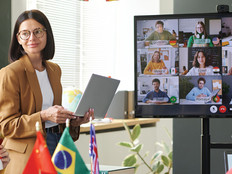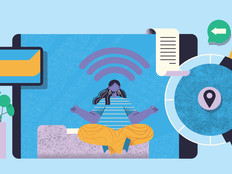Video Conferencing Offers Cost Savings
Schools use the technology for virtual field trips and distance learning.
With the proliferation of high-speed Internet connections, schools are looking for the best ways to utilize this technology other than simply for surfing the web. One of the best applications for a high-speed connection is video conferencing.
Several years ago, when most schools had only a single T1 line, video-conferencing systems began to make inroads. The problem with implementing a video-conferencing system even a few years ago was that the networks, specifically Internet connections, just weren't fast enough to ensure quality performance. More schools are upgrading their Internet connections to 10 megabits per second, 100Mbps or even faster, and can now support this technology.
New video-conferencing systems are available in standard definition (such as the Polycom QDX 6000 series), or even high definition (Polycom HDX series) to match the new large-format displays that are being installed. New-generation video-conferencing systems such as the Polycom HDX devices are portable enough to be rolled easily into a classroom or lab. Many of the current systems can be outfitted with one or two displays (sometimes more), depending on need. But by equipping the video-conferencing cart with only one flat panel display versus two, the system could be attached to the classroom projector, making it easier to transport.
Cost-Savers
Schools can save considerable costs by utilizing a video-conferencing system in place of field trips. When booking a field trip, schools need to consider busing, substitute teachers, permission slips and any fees related to the field trip. All of this can take a considerable amount money from the school, as well as time away from the classroom.
With school budgets feeling the economic pinch, administrators are looking for ways to cut expenses. Utilizing a video-conferencing system to conduct virtual meetings can save on travel expenses for parties on both ends of the connection. As long as each side has a compatible (H.323 standard) system and enough network bandwidth, there is no reason that most meetings could not be conducted virtually.
For individuals needing to video conference regularly, software such as Polycom's PVX software allows the user to conduct video-conference sessions right from his or her desktop computer, all for less than the cost of a typical trip. Standard USB webcams from manufacturers such as Logitech work with the Polycom PVX video-conferencing software as well as VoIP services such as Skype. Teachers and administrators can utilize Skype for quick video calls – whether across the building or across the world – at absolutely no cost.
One of the more innovative uses of video conferencing is for distance learning. Schools can contract with other schools to provide classes that normally wouldn't be available. If your school has only a couple of students who want to learn a foreign language, it certainly doesn't make sense to hire a full-time instructor. Contracting with another school will allow you to offer these types of classes that otherwise would not have been possible. Imagine being able to offer your students a German language class taught by someone who lives in Germany.
When it comes to finding a video-conferencing solution, there are many different options to consider. Costs range from inexpensive webcams and Skype, all the way up to high-definition multisite systems. Do your research, ask others what equipment they are using, and look around your organization for ways to utilize the equipment.







